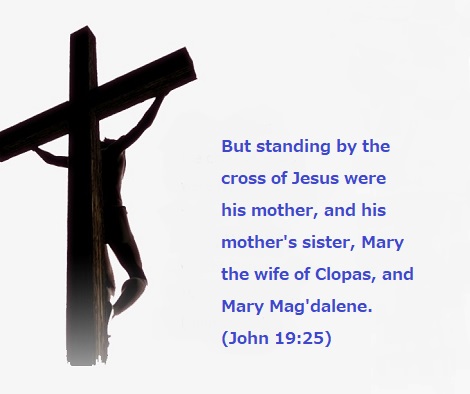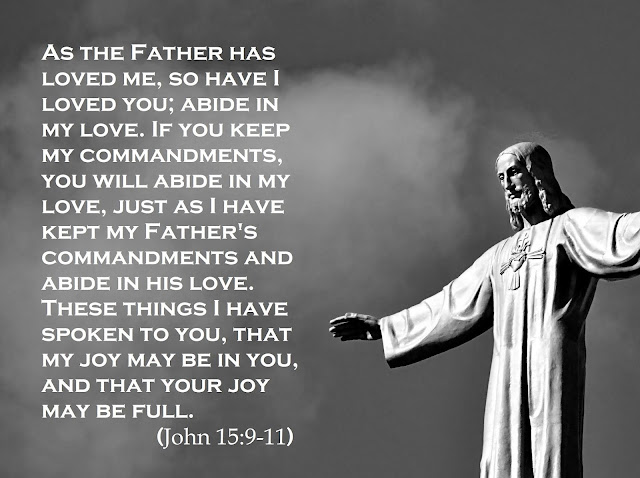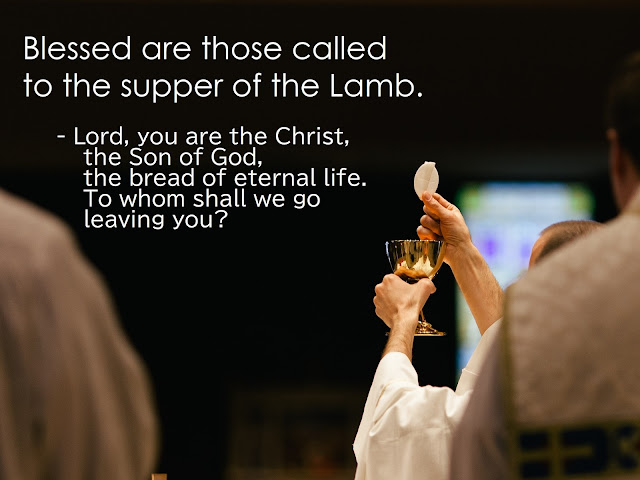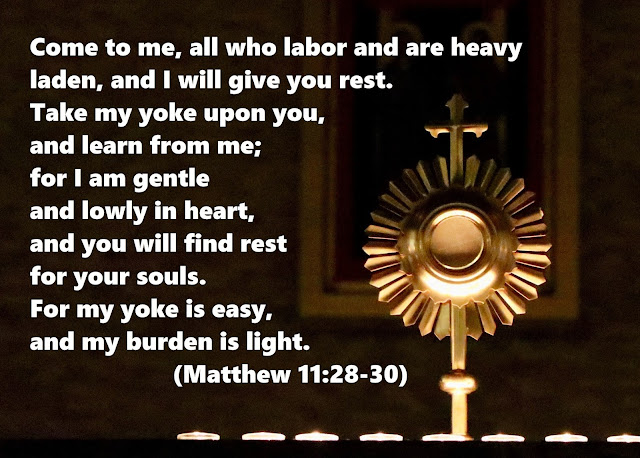The Estuary of Theology 8
The Four People Standing Beside the Cross
I would like to resume the speculation I began in Issue 1 about the four people whom the heavenly Father drew to Jesus on the cross. I began it with looking into the scene of the crucifixion so that I could manage to approach the answer for the question why Christians are still not able to put an end to “the work of man.” It is because I took notice of the fact that John the Evangelist specified the people standing near the cross: the mother of Jesus, Mary the wife of Clopas, Mary of Magdalene and the disciple whom Jesus loved.
The last four issues of this series were devoted to the discussions for proving that the Eucharist is eternal life. In these discussions, I dealt with the priesthood at the same time, which is inseparable from the Eucharist, and as a result, the purpose of Jesus on the cross in having made his beloved disciple take in his mother was made clear. It was to make the men who were to become the cooperators of the Holy Spirit the Apostles and to give them motherhood so that they would produce the Eucharist with the intervention of the Holy Spirit and would become a placenta with an authority of forgiveness and build the relationship of mother and child between the Holy Spirit and man. Upon this relationship, God gives the same bond as the inseparable bond between the Father and the Son (cf. The Estuary of Theology, Issue 4). So, I would like to speculate about the two communities in which the Holy Mother was present, that is, the Holy Family described in the Gospel and the community of people waiting for Pentecost described in the Acts of the Apostles, through the four people near the cross, who are put between these two communities in terms of time.
It is more adequate to understand that God expected the Holy Family to have the same relationship as that of the triune Godhead for Jesus, who was the second person of God and at the same time man, and that each member of the Holy Family accepted this expectation of God. The Holy Family was the first community whose members including Joseph, who had taken the mother and the baby in her womb to his home, lived taking the vocation of “eunuchs who have made themselves eunuchs for the sake of the kingdom of heaven” (Matthew 19:12) so that Jesus the only Son of God would remain the only son also as a man, and because Mary had been overshadowed by the power of the Most High. This characteristic of the Holy Family will be an indispensable requirement if the community is not a family but a public community where many people gather and interact with each other. The Holy Family indeed satisfied this requirement from the beginning.
The four people standing beside the cross have become people of three positions when the mother of Jesus was taken in by the disciple Jesus loved. When we look at them from this point of view, we will realize that each of them corresponds to each of the three roles of the three persons of the Holy Family. Mary the wife of Clopas (some Bible translate it as “Mary the mother of Clopas”) corresponds to Joseph because she was married; Mary Magdalene to Jesus because Magdala is a name of a city and therefore she is supposed to have been single; and the beloved disciple who took in the mother of Jesus to Mary the mother of Jesus together with herself. People whom the heavenly Father drew close to the cross of Jesus had the same composition as that of the Holy Family, which had accepted the mystery of the Incarnation.
Next, let’s take a look at what happened to their three roles when they later joined the community waiting for Pentecost. When we look at the composition of the disciples waiting for Pentecost described by Luke the Evangelist carefully, we will notice that the three roles have converged on the role of Mary the mother of Jesus and the role of Jesus with the role of Joseph being absorbed into these two roles just as the Holy Family had become a family of two persons, the mother of Jesus and Jesus, due to the death of Joseph. “[W]hen they had entered, they went up to the upper room, where they were staying, Peter and John and James and Andrew, Philip and Thomas, Bartholomew and Matthew, James the son of Alphaeus and Simon the Zealot and Judas the son of James. All these with one accord devoted themselves to prayer, together with the women and Mary the mother of Jesus, and with his brothers” (Acts of the Apostles 1:13-14).
According to the description of the Acts of the Apostles, the Apostles, who were to become cooperators of the Holy Spirit, were in the community which was waiting for Pentecost. Following these Apostles, “the women” are put first. Inferring from the description of the Gospels, there were among these women those who are supposed to have been single including Mary Magdalene, widows, and, considering the position of women at that time, those wives, like Mary the wife of Clopas, whose husbands were called Jesus’ brothers and followed him. They stayed close to Jesus and helped the community where Jesus trained the disciples for the Holy Spirit (cf. Luke 8:1-3). As Jesus said about himself, “For which is the greater, one who sits at table, or one who serves? Is it not the one who sits at table? But I am among you as one who serves” (Luke 22:27), and as he was the one who helped the Father by fulfilling his will making it the word and deed, they already lived the role of Jesus as a helper concretely, and they have become the real “helper” which God had expected.
The name “Mary the mother of Jesus” is put next. In this expression, the word “Mary” implies the mystery of the Incarnation, and the word “the mother of Jesus” implies the mystery of the Cross, so the word “his brothers,” which is put immediately after this name, signifies male disciples who followed the Apostles. The Apostles have become Jesus’ brothers since the moment Jesus, on the cross, made one of the disciples an adopted son of his mother. Risen Jesus also called disciples “my brethren” (cf. John 20:17). Then the two men, Joseph and Matthias, who were later nominated following Peter’s proposal are supposed to have been chosen from these people (cf. Acts of the Apostles 1:21-26). So, John the Evangelist described Mary the wife of Clopas standing independently close to the cross of Jesus as a wife who had a husband who lived in this way.
We can find new men and women who were called to build a triune relationship with the Holy Spirit, who is God, as “my church” (cf. Matthew 16:18) in the community waiting for Pentecost, that is, the Apostles, who succeeded the position of Mary the mother of Jesus to become cooperators of the Holy Spirit, and the men who followed them, and the women who succeeded the position of Jesus and have become the true “helper” about which God said, “It is not good that the man should be alone; I will make him a helper fit for him.” (Genesis 2:18). Married men and women who succeeded the position of Joseph are included in each of them. If we interpret “Mary the wife of Clopas” to be “Mary the mother of Clopas,” Mary will be understood to have been a widow and she would have been able to cooperate with Mary Magdalene, who was single, immediately. In this case, it follows that at the time the mother of Jesus was taken in by the beloved disciple, the four people standing near the cross of Jesus could be separated into two positions, the role of Mary the mother of Jesus and the role of Jesus, with the role of Joseph being already absorbed into these two roles.
Now, we can say that the four people standing beside the cross of Jesus were the first “my church,” which has the composition of three roles shifting to two roles just like the Holy Family accepted the death of Joseph, as well as the vocation of “eunuchs who have made themselves eunuchs for the sake of the kingdom of heaven.” The community which once received Pentecost had the composition and the vocation of the Holy Family. People about whom Jesus said, “Here are my mother and my brothers! For whoever does the will of my Father in heaven is my brother, and sister, and mother.” (Matthew 12:49-50) correspond the community waiting for Pentecost. Jesus in public ministry announced people the name of the Father in heaven and showed what people called “my brother” or “my sister” or “my mother” should be. Here is already a sketch of “my church.”
To be continued.
Jan. 2020 in Hiroshima
Maria K




Comments
Post a Comment